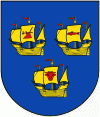Nordfriesland (Kreis Nordfriesland)
 |
 |
As of 2008, Nordfriesland was the most visited rural district in Germany.
The sea has always had a strong influence in the region. In medieval times, storm tides made life in what is now Nordfriesland rather dangerous. Only in modern times was the loss of land and lives able to be stopped by building solid dikes. Many villages that once existed are now at the bottom of the sea. The best-known example is the small seaport of Rungholt, which was destroyed by a storm surge in 1362. The island of Strand vanished in the Burchardi flood, another disastrous storm in 1634. Subsequent to this storm surge, there were many small islets instead of Strand.
From approximately 1200 until 1864, the area that is now Nordfriesland was a part of the Duchy of Schleswig, which itself was not directly a part of the Danish Kingdom, but a fiefdom of the Danish crown and linked to the kings of Denmark by personal union as a separate entity. Nordfriesland is still a multilingual district: there are people speaking standard German, Low German, North Frisian and Danish including South Jutlandic. The North Frisian language exists in nine slightly different dialects, yet it is mainly used by older citizens in mainland Nordfriesland. A relatively lively community of Frisian speakers exists though on the islands of Föhr and Amrum. After becoming German, three districts were established in the region: Südtondern in the north, Husum in the centre, and Eiderstedt in the south. In 1970 these three districts were merged to form the Nordfriesland district.
Map - Nordfriesland (Kreis Nordfriesland)
Map
Country - Germany
 |
 |
| Flag of Germany | |
Various Germanic tribes have inhabited the northern parts of modern Germany since classical antiquity. A region named Germania was documented before AD 100. In 962, the Kingdom of Germany formed the bulk of the Holy Roman Empire. During the 16th century, northern German regions became the centre of the Protestant Reformation. Following the Napoleonic Wars and the dissolution of the Holy Roman Empire in 1806, the German Confederation was formed in 1815.
Currency / Language
| ISO | Currency | Symbol | Significant figures |
|---|---|---|---|
| EUR | Euro | € | 2 |
| ISO | Language |
|---|---|
| DE | German language |
















































